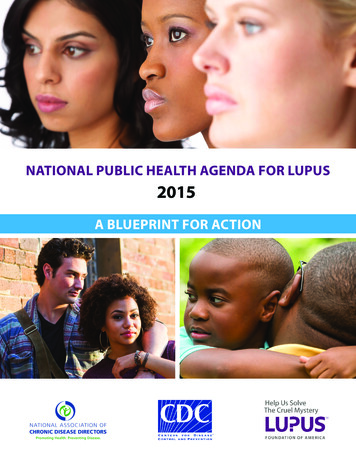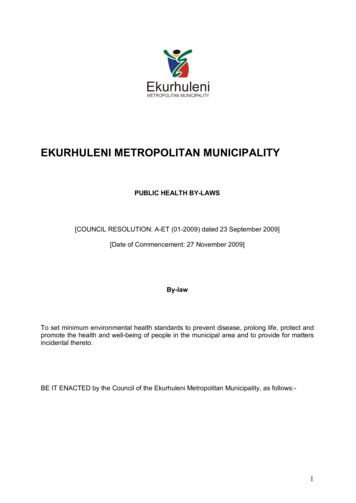
Transcription
NATIONAL PUBLIC HEALTH AGENDA FOR LUPUS2015A BLUEPRINT FOR ACTION
This publication was supported by Cooperative Agreement Number 5U38OT00025-02 from the Centers forDisease Control and Prevention.Its contents are solely the responsibility of the authors and do not necessarily represent the official positionof the Centers for Disease Control and Prevention, the Department of Health and Human Services or the U.S.government.
National Public Health Agenda for LupusA Blueprint for ActionThe National Association of Chronic Disease Directors (NACDD) and the Lupus Foundation of America, withfunding from the Centers for Disease Control and Prevention (CDC), are pleased to present the first-everNational Public Health Agenda for Lupus. The Agenda was developed to prioritize a coordinated and multifaceted public health approach to lupus.Lupus is an unpredictable and misunderstood autoimmune disease that ravages different parts of the body. Itis difficult to diagnose, hard to live with and a challenge to treat. In lupus, the body’s immune system becomesunbalanced, causing inflammation and tissue damage to virtually any organ system in the body, including theskin, joints, heart, lungs, kidney and brain. The symptoms and impact of lupus range in severity from mild tolife threatening. Between 350,000 and 1.5 million Americans and 5 million worldwide live with a form of lupus.While we have seen improved care for individuals with lupus, we still have much work to do to improve thecare and quality of life for people living with the disease, and the public health sector can contribute a greatdeal to this end. A National Public Health Agenda for Lupus provides a blueprint for all stakeholders to guidepublic health action surrounding future policy, planning and advocacy. Recommendations set forth in theAgenda are considered relevant and complementary to efforts in lupus biomedical research and clinical care.The National Public Health Agenda for Lupus is the result of collaboration among a wide variety of stakeholders,including public health and lupus experts, clinicians and individuals living with lupus. The CDC Four Domainsof Chronic Disease Prevention provided the framework for developing the public health approach for lupus.We hope the thoughtful and innovative strategies and recommendations contained in the National PublicHealth Agenda for Lupus will help to advance the fight against lupus.John W. Robitscher, MPHWayne Giles, MD, MSSandra C. RaymondChief Executive Officer Director President & CEONational Association ofDivision of Population HealthLupus Foundation of AmericaChronic Disease DirectorsCenters for Disease Controland Prevention
Table of ContentsExecutive Summary 5Key Public Health Priorities 6Agenda Contributors 8The Need For Action10BackgroundDiagnosis and TreatmentRisk FactorsBurden of DiseaseHealth Disparities1111121213Development of the Agenda14Agenda MethodsFour Domains of Chronic Disease PreventionKey Values151516Strategies and Recommendations18Domain 1 - Epidemiology and SurveillanceDomain 2 - Environmental ApproachesDomain 3 - Health Care Systems InterventionsDomain 4 - Community Programs Linked to Clinical Services18202224The Future26Glossary28Endnotes30
While there are several forms of lupus, systemic lupus erythematous (SLE), a chronic,autoimmune disease that can damage any part of the body, is the most serious formof lupus. Existing prevalence estimates range from 322,000 with definite or probableSLE 1 to 1.5 million Americans living with some form of lupus.2 Lupus affects womennine times more often than men,3 with 80% of new cases developing between theages of 15 and 44.4 Lupus is three times more common among women of color thanwhite women.While there has been progress in managing lupus over the past decade, there isstill much work to do to improve the care and quality of life for people living withthe disease. To help fight lupus and improve the quality of life for the people livingwith the disease, the Centers for Disease Control and Prevention (CDC) funded theNational Association of Chronic Disease Directors (NACDD) in collaboration with theLupus Foundation of America to develop a National Public Health Agenda for Lupus.The Agenda is organized and framed under the CDC Four Domains of ChronicDisease Prevention that include epidemiology and surveillance; environmentalapproaches; health care system interventions; and community programs linked toclinical services. The Agenda also addresses health disparities and communicationstrategies.This Agenda provides a broad public health approach to lupus diagnosis, diseasemanagement, treatment and research. The six priorities, 15 strategies and 63recommendations set forth in the Agenda will guide the public health communityto plan effective lupus initiatives, and will complement efforts in lupus biomedicalresearch and clinical care.Executive SummaryLupus is a complex, chronic, inflammatory autoimmune disease in which anunknown trigger causes the immune system to attack the person’s own tissues.Lupus can impact virtually any organ system of the body, including the skin, joints,kidney, brain, heart, lungs, blood and blood vessels. There is no known causeor cure for lupus, which can cause severe kidney disease, stroke and prematurecardiovascular disease.
Key Public Health PrioritiesNational Public Health Agenda for LupusThe Agenda outlines a series of strategies and recommendations aligned withthe CDC Four Domains of Chronic Disease Prevention. Contributors to theAgenda defined six key public health priorities: Create better case definitions of lupus that are appropriate for clinicaldiagnosis, surveillance and research. Expand epidemiology, surveillance and public health research forincidence, quality of care, adverse outcomes and mortality, with a highpriority for those studying health disparities. Develop, improve and increase the availability of evidence-baseddisease self-management programs and techniques. Enhance local, regional and national capacity to provide informationand resources for people with lupus, their families, friends and caregivers,providers, public health practitioners and researchers. Support the development of robust care coordination modelsthat facilitate collaboration between primary care providers andrheumatologists. This will help ensure people with lupus are diagnosedearly and receive appropriate treatments, preventive health screeningsand services and a smooth transition from pediatric to adult care. Implement public awareness campaigns clearly illustrating thecomplexities of lupus and the importance of early identification anddiagnosis and effective disease management.6
“Lupus is three times more common amongwomen of color than white women”7
Agenda ContributorsSteering CommitteeAlexis Adams, MPHSciMetrika, LLCLeslie A. BestNational Association of Chronic Disease DirectorsCharles G. Helmick, MDCenters for Disease Control and PreventionSusan Manzi, MD, MPHAllegheny Health NetworkKathleen A. ArntsenLupus and Allied Diseases AssociationLiving with LupusKimberly Cantor, MPALupus Foundation of AmericaS. Sam Lim, MD, MPHEmory UniversityLauren TopfLupus Foundation of AmericaConference ParticipantsFrances Ashe-Goines, RN, MPHDepartment of Health and Human Services(Retired)Bill Benson (Meeting Facilitator)Health Benefits ABCsTimothy Beukelman, MD, MSCEUniversity of Alabama at BirminghamVanessa Briggs, MPH, RN, LDN*Public Health Management CorporationSheree Carter, RN, PhDUniversity of Alabama Capstone College ofNursingEliza Chakravarty, MD, MSOklahoma Medical Research FoundationYvonne Cook, MPAHighmark Foundation, Inc.Glinda Cooper, PhDUnited States Environmental Protection Agency* denotes workgroup chair8Karen Costenbader, MD, MPHHarvard Medical SchoolCristina Drenkard, MD, PhDEmory School of MedicineKeri-Ann Faley, RHIAPennsylvania Department of HealthChristy FathLiving with LupusElizabeth Ferucci, MD, MPH, FACPAlaska Native Tribal Health ConsortiumPamela GreenbergLiving with LupusJoanne Grossi, MIPP*Department of Health and Human ServicesAfton Hasset, Psy.D.University of Michigan Medical SchoolCasey Hannan, MPHCenters for Disease Control and Prevention
Peter Izmirly, MDNew York University School of MedicineWendy Rodgers, MEdLiving with LupusBrian KaplanLiving with LupusPatrick RowenaThe Advertising CouncilMariana Kaplan, MDNational Institute of Arthritis andMusculoskeletal and Skin DiseasesJeffrey Sacks, MD, MPHSue Binder Consulting, Inc.LaTasha Lee, PhD, MPHCongressional Black Caucus FoundationMimi Lising, MPHNational Institute of Arthritis andMusculoskeletal and Skin DiseasesSarah Lyon-Callo, MA, MSMichigan Department of Community HealthSheryl McCalla, JD*American College of RheumatologyJoan Merrill, MDOklahoma Medical Research FoundationRanit Mishori, MD, MHS, FAAFPGeorgetown University School of MedicineJill Myers Geadelmann, BS, RNNational Association of Chronic DiseaseDirectorsAna Nunez, MDDrexel University College of MedicineHilary Parton, MPHNew York City Department of HealthSandra C. RaymondLupus Foundation of AmericaKim SchofieldLiving with LupusEmily Somers, PhD, ScMUniversity of Michigan School of MedicineDoug Spotts, MD, FAAFPPennsylvania Academy of Family PhysiciansTammy Utset, MD, MPHUniversity of Chicago Department of MedicineDaniel Wallace, MDCedars-Sinai Medical CenterMichael Ward, MD, PhDNational Institute of Arthritis and Musculoskeletaland Skin DiseasesGretchen WartmanNational Minority Quality ForumVictoria Werth, MDUniversity of PennsylvaniaEdward Yelin, PhD, MCPUniversity of California, San FranciscoAlice Yoder, RN, MSNLancaster General HealthRosalind Ramsey-Goldman, MDNorthwestern University Feinberg School ofMedicine9
There is no known cause or cure forlupus, which can cause kidney disease,stroke and premature cardiovasculardisease.10
The Need for ActionBackgroundLupus is a complex, chronic, inflammatory autoimmune disease in which an unknowntrigger causes the immune system to attack the person’s own tissues. Lupus can affectvirtually any organ system of the body, including the skin, joints, kidney, brain, heart, lungs,blood and blood vessels. There is no known cause or cure for lupus, which can cause kidneydisease, stroke and premature cardiovascular disease.There are several forms of lupus, with systemic lupus erythematosus (SLE) being the mostserious form of lupus. Other forms of lupus include cutaneous lupus erythematosus, whichis limited to the skin; drug-induced lupus erythematosus, a lupus-like disease caused bycertain prescription drugs that typically ends when the drug is stopped and neonatal lupuswhich is a rare temporary condition caused by antibodies from the mother acting upon theinfant in the womb. The term lupus is used throughout the Agenda to encompass all formsof the disease; however, some data cited may be specific to SLE, and is so noted.People with lupus sometimes have symptoms that are characteristic of one or more ofthe other connective tissue diseases, such as rheumatoid arthritis, scleroderma, Sjögren’ssyndrome and various forms of vasculitis. Other conditions that can occur among peopleliving with lupus include depression, cardiovascular disease and atherosclerosis.Diagnosis and TreatmentThere is no specific test to diagnose lupus, making diagnosis challenging for many primarycare providers. This may result in delayed diagnosis and medical treatment. Many peoplewith lupus report being incorrectly diagnosed or experience delays in obtaining an accuratediagnosis. Of those who report an incorrect diagnosis, more than half report seeing fouror more different health care providers for their lupus symptoms before being accuratelydiagnosed.Late diagnosis and delayed treatment contribute to pooroutcomes and increased morbidity and mortality. Improvedknowledge of lupus among health care professionals mayresult in earlier and more accurate diagnoses. This, in turn,could help to improve disease management and quality of life,while diminishing adverse effects for people living with lupus.611
The Need for ActionThe clinical spectrum of lupus ranges from mild to life threatening. Lupus is a disease offlares in symptoms and disease activity. Complications can arise suddenly. As a multi-systemdisease, people living with lupus regularly see primary care providers as well as severalmedical specialists.7,8There are limited options available for treatment of lupus. Belimumab, approved by theFDA in March 2011, is the first and only drug designed specifically to treat lupus. Most othermedications used to treat lupus are prescribed off-label. These medications do not cure lupusand often have significant side effects.Risk FactorsMost risk factors for lupus are not modifiable. However, certain modifiable environmentalfactors have been linked to the development or aggravation of symptoms of lupus, such asexposure to fine particulate matter or silica. Many people with lupus find their disease ismade worse by exposure to ultraviolet rays from sunlight or artificial light, which may requireadaptations both at home and in the work setting.Burden of DiseaseMany people with lupus experience ongoing inflammation and damage, which contributeto general fatigue, chronic pain, mood disturbances, poor sleep quality and cognitiveimpairment.9 Fatigue is experienced by about 85% to 92% of people living with lupus; fiftypercent of people living with lupus rate fatigue as the most disabling symptom of lupus.10People with lupus can have a significantly lower quality of life than people with other chronicdiseases.11SLE is a costly condition. Mean annual expenditures for persons with SLE were 12,238 greaterthan those for persons without SLE; for persons with SLE related nephritis, mean medicalexpenditures were 46,862 greater than for persons without SLE. Persons with SLE relatednephritis had the highest average per patient annual cost at 64,195, when compared with 10other chronic diseases.12Lupus can interfere with work. One study found that more than 40% of people with SLE wereno longer employed an average of 3.4 years after their diagnosis. Socioeconomic factors thatcontributed to not working were lower levels of education, lack of private health insurance,higher amount of physical activity required for the job and higher disease activity at the timeof diagnosis.1312
Health DisparitiesRecent studies indicate that lupus incidencerates are almost three times higher in blackwomen than white women, and affect 1 in 537young African American women.14,15 Minoritywomen tend to develop lupus at a youngerage, experience more serious complicationsand have higher mortality rates—up to threetimes the mortality rate of white women.16Young black women who have lupus nephritistend to have a more severe disease courseand are more likely to progress to endstage renal disease. In addition, non-whitepatients are more likely to suffer from lupusrelated depression, cardiovascular diseaseand diabetes and have worse health-relatedquality of life than white patients. 17, 18 Healthdisparities are extremely complex, and mayplay a role in the burden of lupus nephritisin this population. Disparities may be due togenetics, disease comorbidities and a varietyof social determinants that influence healthoutcomes.13
Experts and stakeholders, includingpeople living with lupus, convenedto develop the strategies andrecommendations for this Agenda.14
Development of the AgendaAgenda MethodsThe Centers for Disease Control and Prevention (CDC) funded the National Association ofChronic Disease Directors (NACDD) in collaboration with the Lupus Foundation of Americato develop a National Public Health Agenda for Lupus.The Agenda provides a broad public health approach tolupus to help guide future policy, planning, advocacyand action intiatives.A Steering Committee was established in September 2014 to provide guidance withproject planning. The Steering Committee agreed on a comprehensive approach to theAgenda that used the CDC Four Domains of Chronic Disease Prevention and a set of keyvalues. The Committee also sought a wide variety of experts and stakeholders in lupus andpublic health to contribute to the effort.Four Domains of Chronic Disease PreventionThe National Public Health Agenda for Lupusis organized and framed under the CDC FourDomains of Chronic Disease Prevention.5 Epidemiology and Surveillance toprovide data to define and prioritizepublic health problems. Environmental Approaches topromote health and support healthybehaviors. Health Care System Interventions toimprove the delivery and use of clinicaland other preventive LinkagesEnvironmentalApproachesHealth CareSystemInterventions Community Programs Linked toClinical Services to ensure access topreventive and self-management resources.15
Development of the AgendaRecommendations to address health disparities and communication strategies are alsoincluded in this Agenda.Key ValuesThe Steering Committee endorsed the following key values in support of a public healthapproach to lupus: Enhance the capacity for lupus data collection and surveillance to detect trendsin diverse populations and across the U.S. Increase the supply and distribution of trained health care providers toprovide early diagnosis, effective disease management and referral services. Promote clinical and community-based resources that support people living withlupus and their families. Implement communication strategies to illustrate evidence-based practices,effective treatment methods, and the burden of lupus. Investigate factors that contribute to inequities and disparities in health outcomes.Subject matter experts and stakeholders participated in one of two February teleconferencesto explain both lupus and public health. On March 10 and 11, 2015 in Washington, DC, morethan 50 experts and stakeholders, including people living with lupus, convened to developthe strategies and recommendations for the Agenda. The result is the first-of-its kind NationalPublic Health Agenda for Lupus that provides a wide-range of public health recommendationsintended to complement efforts in lupus biomedical research and clinical care.16
This Agenda provides a broad publichealth approach to lupus diagnosis,disease management, treatment andresearch, and serves as an overallblueprint for action in lupus to helpguide future policy, planning, advocacyand action initiatives.17
Strategies and RecommendationsDomain 1: Epidemiology and SurveillanceObjective: To provide essential data toStrategy 1-2:define and prioritize public health problems,identify populations most affected, guidesolutions and monitor progress andinformation.5Assess and monitor thequality and timeliness ofcare for people living with lupusRecommendationsStrategy 1-1:Monitor long-term trends inthe burden of lupus Assess the percent of people withlupus who receive appropriateinterventions including, but not limitedto immunizations; preventive health andbehavorial health screenings; medicationuse and adherence; use of complementaryand alternative medicine; disease selfmanagment techniques; family planning;and frequency of health provider visits.Recommendations18 Expand the study of incidence andprevalence of lupus among racial andethnic minorities. Use a variety of existing national surveys tomore accurately determine the burden oflupus. Develop and evaluate the implementationof uniform quality of care indicators inlupus. Analyze survey results over time,geographic area and demographics. Encourage states to use national andstate-based data sources to determine theburden of lupus.Examine disparities in quality of careindicators by age, gender, race/ethnicity,income and geographic location. Revise existing or develop new surveillancesystems or measures to address lupusburden estimates.Assess social determinants of health forpeople with lupus including, but notlimited to, availability of resources tomeet daily needs; access to health careservices; transportation; social support;socioeconomic conditions; employment. Increase the capacity of national, stateand local partnerships to address lupus,including data collection andself-management resources. Develop best practice guidelines formanaging lupus with attention to the useof glucocorticoids.
Strategy 1-3:Assess and monitor quality oflife among people living with lupusRecommendations Evaluate existing quality of life tools anddevelop new instruments as needed. Use multiple data sources to determinequality of life for people with lupus. Datasources may include surveys or assessmenttools within lupus registries, at infusioncenters, through patient advocacyorganizations and in the general population. Strategy 1-5:Strategy 1-4:Monitor the knowledge oflupus among health care professionalsExpand research in lupus, includingepidemiologic, surveillance andpublic health researchRecommendationsRecommendationsEvaluate the understanding by health careprofessionals of diagnosis, management,disease progression and other conditionsassociated with lupus; care coordinationprocesses among specialists and referralsto self managment resources; the transitionfrom pediatric to adult care; and knowledgeof pregnancy related issues, including theuse of appropriate medications.Health care professionals to be assessedinclude, but are not limited to, practitionersof family and internal medicine, pediatrics,obsetrics and gynecology, rheumatologyand dermatology (including physicianassistants and nurse practitioners). Create better case definitions of lupusthat are appropriate for clinical diagnosis,surveillance and research. Determine risk factors for developing lupus. Support research to improve ways toidentify those at highest risk for developinglupus or those at risk for organ involvement,and that facilitates earlier diagnosis, diseasemonitoring and prediction of flares. Assess the impact of environmental riskfactors at home and in the work place. Assess factors that influence access tocare and adherence with management,including medications.19
Domain 2: Environmental ApproachesObjective: To promote health and supporthealthy behaviors across the nation, in statesand communities, and in settings such asschools, childcare programs, work sites andbusinesses.5Strategy 2-1:Strategy 2-2:Ensure full participation in the work forceand ability to access services when work isnot an optionRecommendations Recognize lupus as a disease that mayrequire Americans with Disabilities Act(ADA) accommodation such as flex time,work from home and potential physicalaccommodations. Work with the Social Security Administration(SSA) to support the inclusion of a diagnosisof lupus into the Social Security DisabilityInsurance (SSDI) Compassionate AllowancesProgram. Collaborate with the SSA to revise theSSDI guidance to accurately reflect thedocumentation of lupus intangibles, suchas pain and fatigue, as well as the specificmeasurable assessments of visible physicalhealth.Implement integrated, comprehensive,coordinated patient-centered care models forlupus to improve overall health outcomes andquality of lifeRecommendations Develop innovative and cost-effectivemodels for integrated, comprehensive,coordinated patient-centered health caredelivery for people with lupus and theirfamilies. Document the cost-effectiveness andimproved health outcomes of thecoordinated care models. Develop criteria for certification of themodels as comprehensive lupus centers.Strategy 2-3:Work with the U.S. Department of Health andHuman Services to establish a lupus specificsection in Healthy People 2030Recommendations20 Convene representatives from the lupuscommunity and public health officials toestablish lupus as a topic area separatefrom arthritis. Develop lupus specific goals and objectivesfor Healthy People 2030, including thosespecific to disparities faced by people livingwith lupus.
Strategies and Recommendations21
Strategies and RecommendationsDomain 3: Health Care Systems InterventionsObjective: To increase the use and improvethe quality of clinical and other preventiveservices.5Strategy 3-2Improve the quantity, distribution andeducation of health care providers who delivercare to people with lupusRecommendationsStrategy 3-1:Ensure early diagnosis and access to lupus careand treatments Support training and education thatpromotes an integrated approach to lupuscare, inclusive of public health, nutrition,social work, pharmacy, behavioral health andmedicine. Establish a task force to work with theHealth Resources Services Administration(HRSA) to expand the National Heath ServiceCorps Loan Repayment Program to includerheumatology as a qualified specialty. Increase the number and distribution ofrheumatology fellowship programs. Encourage practitioner fluency in otherlanguages, especially Spanish, or ensure theready availability of translators to improvecare, compliance and access to care. Develop a clinician certification program inlupus diagnosis and care. Collaborate with health professionalassociations to increase and developeducational opportunities about lupus,with a focus on educating primary carepractitioners, obstetricians/gynecologists,ophthalmologists, dermatologists,mental health specialists, emergencyroom physicians, pharmacists, nurses andpractitioners in urgent care settings. Expand Teaching Fellows in Lupus intoadditional areas with high minoritypopulations who are at increased risk forlupus. Develop best practices on the use ofalternative therapies.Recommendations 22Support the development and validationof diagnostic criteria including a casedefinition, and tools to help health careproviders make an early and accuratediagnosis.Increase the role of technology in earlydetection and disease managementby developing novel mobile apps andsupporting the expansion and integrateduse of tele-health and electronic healthrecords.Support prescription drug formulariesthat do not delay access to effective lupustherapies and treatments.Eliminate policies, such as “fail first”that create barriers to accessing vitalmedications.Promote and support the establishment ofthe Patient Centered Medical Home modelfor people with lupus to ensure accessto primary care and timely preventivescreenings.
Strategy 3-3:Strategy 3-5:Improve the transition from pediatrics toadult care for people with lupusIncrease participation in clinical trialsand research with a focus on populationsdisparately affected by lupus or who arehistorically underrepresented in clinical trialsRecommendations Expand the Childhood Arthritis andRheumatology Research Alliance (CARRA)Registry to investigate long-term outcomesof childhood-onset lupus and the transitionof care to adult rheumatologists. Create culturally appropriate and sensitiveeducational materials about the benefits ofparticipation in a clinical trial. Develop recommended practice proceduresfor transition. Encourage HRSA to direct states to includechildren and adolescents with lupus as anessential part of the regularly scheduledstate needs assessment for Title V funding.Develop strong local and communityleaders to create trust and promoteparticipation in clinical trials and research. Promote the need and understanding toengage in clinical trials and use effectiveculturally appropriate recruitmentmechanisms to improve the connection ofpeople with lupus with clinical trials andacademic sponsors. Support new and innovative clinicaltrial designs across clinical andsociodemographic subpopulations tofacilitate drug discovery in lupus andidentify new targets for drug development.RecommendationsStrategy 3-4:Improve health promotion and familyplanning for people living with lupusRecommendations Develop standards and models of care andeducation that address wellness and thespecial reproductive health needs of peoplewith lupus, including fertility and familyplanning. Encourage and improve partnerships at thenational and state level to support the useof best practices in health promotion suchas smoking cessation. Improve the ability of state healthdepartments to address lupus bydeveloping a template lupus action planfor effective program planning for lupusthat can be replicated in state healthdepartments across the country. Encourage appropriate referrals to chronicdisease early detection programs.23
Domain 4: Community Programs Linked to Clinical ServicesStrategy 4-2:Objective: To ensure that people withIncrease awareness of lupusand available resources amongall stakeholdersor at high risk of a chronic disease, likelupus, have access to resources they need toprevent or manage their disease.5RecommendationsStrategy 4-1:Promote the development and use ofeffective community-basedself-management resources Establish national awareness campaigns onlupus targeting a variety of audiences. Create educational materials with effectivelinkages to organizations that representother diseases which may affect peopleliving with lupus, such as cardiovascular andkidney diseases. Expand the 211 system in all states toinclude pathways for access to care, clinicaland community support programs forpeople with lupus.Recommendations 24Leverage collaborations among communityand faith-based organizations, schools,health care systems and employers topromote and market community-based selfmanagement services for people living withlupus. Ensure data sharing between communityresources and the clinical setting to monitorimpact/effectiveness of self-managementservice. Develop and enhance local, regional andnational clearinghouse capacity for peoplewith lupus and their families, as well ashealth care providers. Collaborate with lupus centers to developa tool to support disease self-managementfor people with lupus, and integrate the toolinto standards of practice. Educate state health departments of theimportance of implementing data collectionsystems for lupus or
Agenda defined six key public health priorities: Create better case definitions of lupus that are appropriate for clinical diagnosis, surveillance and research. Expand epidemiology, surveillance and public health research for incidence, quality of care, adverse outcomes and mortality, with a high priority for those studying health .











